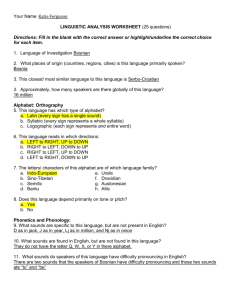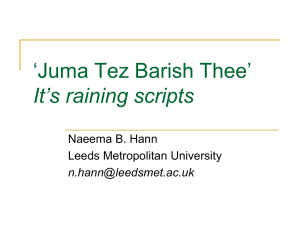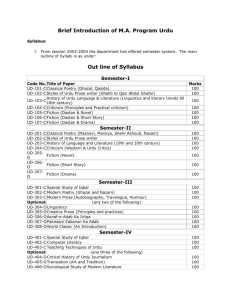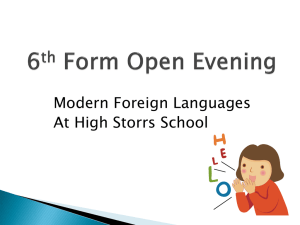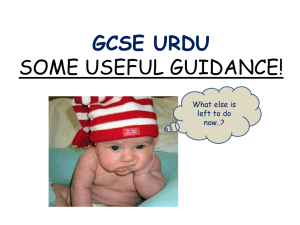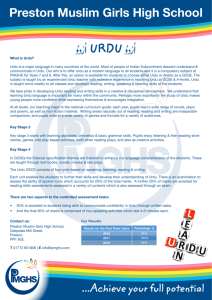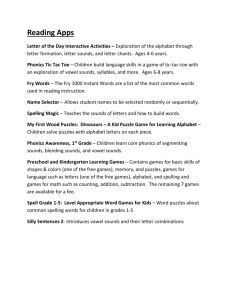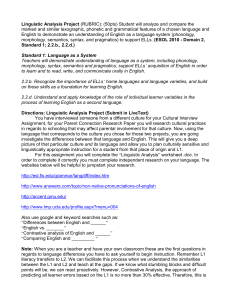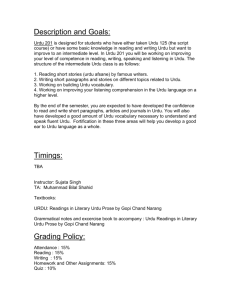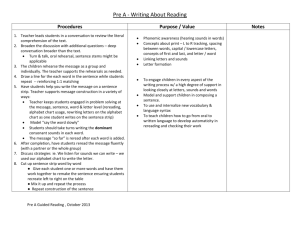Urdu
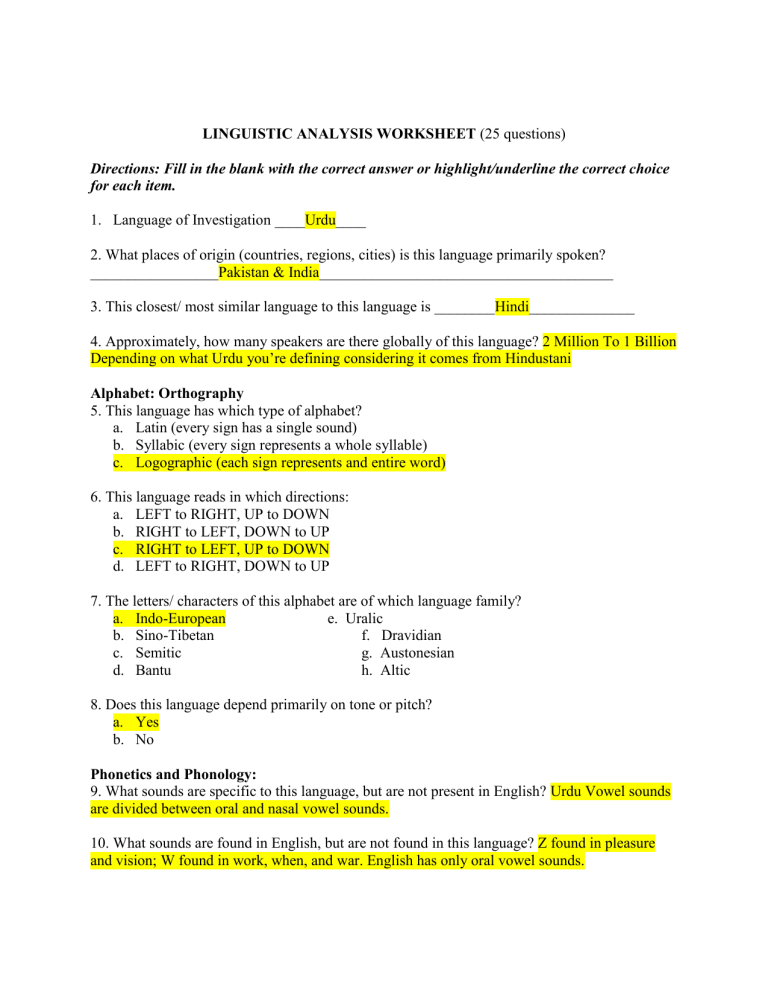
LINGUISTIC ANALYSIS WORKSHEET (25 questions)
Directions: Fill in the blank with the correct answer or highlight/underline the correct choice for each item.
1. Language of Investigation ____Urdu____
2. What places of origin (countries, regions, cities) is this language primarily spoken?
_________________Pakistan & India_______________________________________
3. This closest/ most similar language to this language is ________Hindi______________
4. Approximately, how many speakers are there globally of this language? 2 Million To 1 Billion
Depending on what Urdu you’re defining considering it comes from Hindustani
Alphabet: Orthography
5. This language has which type of alphabet? a. Latin (every sign has a single sound) b. Syllabic (every sign represents a whole syllable) c. Logographic (each sign represents and entire word)
6. This language reads in which directions: a. LEFT to RIGHT, UP to DOWN b. RIGHT to LEFT, DOWN to UP c. RIGHT to LEFT, UP to DOWN d. LEFT to RIGHT, DOWN to UP
7. The letters/ characters of this alphabet are of which language family? a. Indo-European e. Uralic b. Sino-Tibetan c. Semitic d. Bantu f. Dravidian g. Austonesian h. Altic
8. Does this language depend primarily on tone or pitch? a. Yes b. No
Phonetics and Phonology:
9. What sounds are specific to this language, but are not present in English? Urdu Vowel sounds are divided between oral and nasal vowel sounds.
10. What sounds are found in English, but are not found in this language? Z found in pleasure and vision; W found in work, when, and war. English has only oral vowel sounds.
11.
What sounds do speakers of this language have difficulty pronouncing in English? Speaker of the Urdu language have problems pronouncing words with silent letters. Speakers will be inclined to pronounce all letters. Urdu speakers have difficulty pouncing words with numerous sounds. There may also be some problems with patterns of speech.
Syntax and Grammar:
12. The word order of this language is a. Verb, subject, object (VSO) b. Subject, verb, object (SVO) c. Object, verb, subject (OVS) d. Verb, object, subject (VOS) e. Subject, object, verb (SOV) f. Lacks a dominant word order
13. Are there particular parts of speech that are represented differently (such as articles or prepositions)? No
14. How are tense and aspect indicated? Verbs inflect for mood, tense/aspect, number, and person.
15. What are the punctuation forms used in this language? List using English comparisons.
؟ںیہ ےسیک پآ
How are you?
! !ےہ ترورض یک ددم ےھجم
I need help!
.ےہ لصاح ھدود روا ،اناج ںیم ناکد یک سا ینابرہم ہارب
Please go to the store, and get milk.
16. How does this language mark gender? Male and female by their titles (mother and father)
Morphology: Remember that cognates have the same origin; they are not simply words that sound alike.
17. If there are some shared cognates between English and this language, what are they?
If not, why not? Jungle from Jangal, Pajama from Payjamo, Sentry from Santri, Shampoo form Champu
18. If there are some FALSE cognates between English and this language, what are they?
If not, why not? There are no false cognates in Urdu
Semantics:
19. How is formality or respect expressed? Calling people by their titles such as Mother, Father,
Grandmother; if a stranger call them Uncle or Aunt
20. What is an informal expression in this language? What is the English translation/meaning?
Hafiz Pasha Khuda Khair Kare; Yo dude what’s up what u doing?
Or/ یو ؟
وہ ےہر رک مت ھچک وج ےہ ایک تسود
(Has the same meaning)
Pragmatics:
(Has the same meaning)
21. What is the common expression for greetings? (In English, we ask “How are you?”)
Salam! ! Hi,
Salam Alekum/Subha Ba-khair! Good Morning,
Khush Aamdeed Welcome,
Kya Hal Hai? How are you?
22. Are there certain topics that are considered inappropriate or forbidden? Forbidden conversations in Pakistan are topics about drugs, alcohol, prostitution, and anything that goes against Muslim religion.
Teaching Implications:
23. Through your research what have you found are the biggest difficulties of speakers of this language learning English? Please provide specific examples. How my ELL student would read text in my classroom will be a huge difficulty, in English we read left to right but in Urdu text is read right to left. If I am working with a student who is a fluent reader Urdu will be harder to teach English direction of text. Another difficulty my ELL student would face is English ways of forming sentences. We say sentences in SVO in Urdu it would be SOV. How they write their sentences will show incorrectly, because that’s how it is said in their head.
24. If you have an early production ELL who this language is their L1, what would be the most important thing you will teach them in regards to the difference between their language and
English? The most important things I would show my early production ELL students to contrast
English and Urdu are the sentence forms, way of reading text, and our alphabet with proper vowel pronunciation.
25. What would you expect to be ongoing difficulties for intermediate ELLs who this is there
L1? What areas would you still need to address even after they had mastered social English?
With my intermediate ELL students things to work on even after mastering the social part of
English will still be pronunciation of letter and letter combination. Reading and writing. These practices need constant practice and observation to make sure they wouldn’t fall back into native ways they originally learned that would confuse them or construct wrong answers.
* Note: When you are a teacher and have your own classroom these are the first questions in regards to language differences you have to ask yourself to begin instruction. Remember L1 literacy transfers to L2. We can facilitate this process when we understand the similarities between the L1 and L2 and teach at the gaps. If we know what stumbling blocks and difficult points will be, we can react proactively. However, Contrastive Analysis, the approach of predicting all learner errors based on the L1 is no more than 30% effective. Therefore, this is only one consideration in language teaching. You may want to save this worksheet in your
"teacher resources" file for future use.
